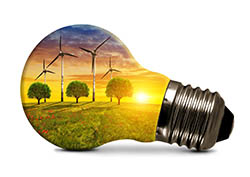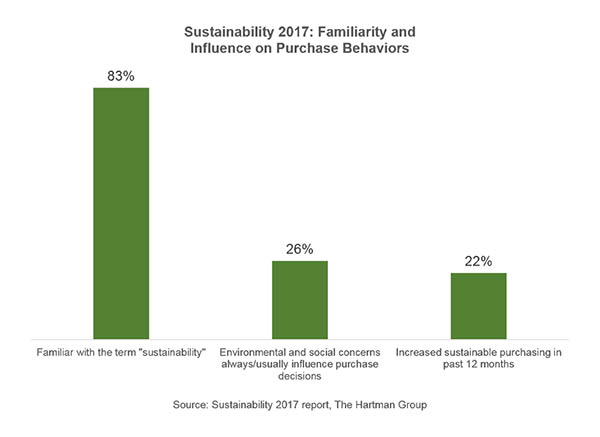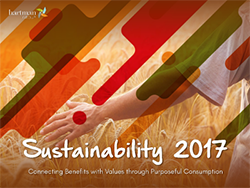Sustainability Today: Living Green in an Era of Risk and Uncertainty
 In 2017, it is twenty years since The Hartman Group provided the first important insights into consumers’ green behaviors gained from our landmark Food and the Environment research. Back then, we learned that despite a clear resonance among half of the American population toward earth-sustainable products, green attitudes did not necessarily translate into green behavior.
In 2017, it is twenty years since The Hartman Group provided the first important insights into consumers’ green behaviors gained from our landmark Food and the Environment research. Back then, we learned that despite a clear resonance among half of the American population toward earth-sustainable products, green attitudes did not necessarily translate into green behavior.
While marketers of sustainable products in the 1990s hoped consumers would “vote with their dollars” when purchasing goods and services, it turned out that for everyday shoppers entering a store (or online), the top-of-mind purchase driver was not “I’m going to buy environmentally today.” Except for the die-hard “Core” green consumers (who never stopped embracing pure green ideals), a vast amount of the consumer behavior coinciding with the term “sustainability” has instead focused on a general consumer drive to ameliorate risks to self and children and — depending on personal mindset — to community, country and finally the globe.
This intrinsically human orientation toward sustainability centers squarely on how everyday consumers cope with what they view as threats posed to their air, water, food, and local and global environment.
The greatest show of force in the rise of organic foods and the general cultural shift toward health and wellness in the U.S. occurred in the period between 1997 and 2017. Importantly, as we’ve learned through these two decades of research on organic products, the primary drivers leading the majority of today’s consumers to organics are not spiritual concerns for “the environment” but are instead pragmatic reactions to events that cause a greater focus on personal and family health and wellness.
Living Green in an Era of Risk and Uncertainty
If we take the rise of the organic market in the U.S. over the past twenty years less as a barometer of a consumer resonance toward products that are earth-sustainable but more as a testament to the health and wellness lifestyle drivers that influence the majority of organic buyers today, we can use such a reading as an indicator of the general climate that makes up the consumer perspective on the term “sustainability” today.
Sustainability is a hot media and public interest umbrella term used to describe the current cultural movement toward health, wellness, organics, environmental consciousness, simple living, responsible consumerism and other lifestyle trends.
Awareness of and familiarity with sustainability has reached an all-time high of 83 percent of consumers in 2017 (compared with 54 percent in 2007), according to The Hartman Group’s Sustainability 2017: Connecting Benefits With Values Through Personal Consumption report. Yet, as we’ve witnessed over the past twenty years, familiarity with the term is not a purchase driver. Today, only about a fourth of consumers (26 percent) claim that environmental and social concerns impact much of their purchasing, and only about one in five (22 percent) say they’ve increased sustainable purchasing in the past 12 months

In 2017, consumers view sustainability more holistically than ever before, as encompassing interconnected sets of issues related to being both a responsible consumer and a responsible citizen. While retaining strong environmental associations, sustainability also overlaps with personal benefits, especially those related to health and wellness.
Partly due to the current political moment, environmental and social justice issues have become household talking points, regardless of one’s political affiliation.
- Debate around the Paris Agreement on climate change, record-breaking weather events and natural disasters has brought global warming home for many consumers in a much more tangible way than in the past.
- Increasing awareness of economic inequality, health coverage and the role of immigration in our economy has brought labor back to the forefront.
- Consumers across the political spectrum care about sustainability, though the issues they prioritize may differ. Conservatives often place a higher value on economic factors, while liberals are drawn to social issues.
At the same time, sustainable products and services are more available and affordable than ever.
- Greater access to sustainable products means that the Core can shop more channels and consumers beyond the Core are able to consider and try them.
- For many consumers, especially Millennials, sustainability-related attributes like organic, grass-fed or plant-based are also quality cues.
- The more consumers perceive sustainability to overlap with personal benefits — health, quality, thrift — the more compelling sustainable products become.
The “Green” Bottom Line Twenty Years On
Given all the changes in the past 20 years, there continues to be a shift in consumer interest toward companies, brands, products and services that embody consumers’ values. The dynamics of sustainability in American consumer culture will also continue to change and evolve, just as so-called “green” and “environmental” markets have evolved. There is a broad range of sustainable products and services that intersect in different ways with both the world of consumers and the world of sustainability. There is no boilerplate formula to make connections with consumers. This presents retailers and manufacturers with opportunities. Developing a keen understanding of the current consumer attitudes, behaviors and trends is your most valuable tool in identifying emerging opportunity spaces.

